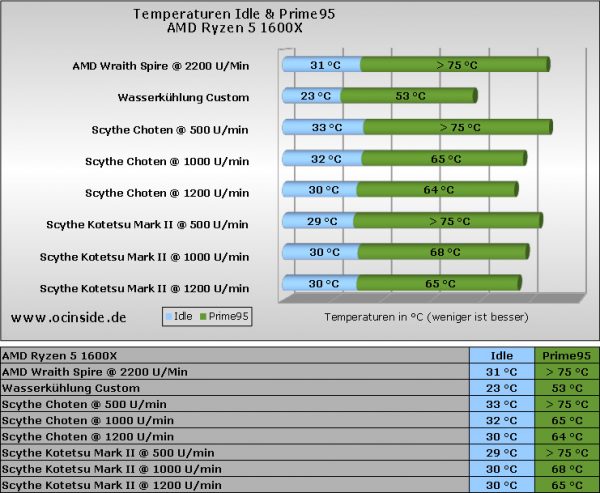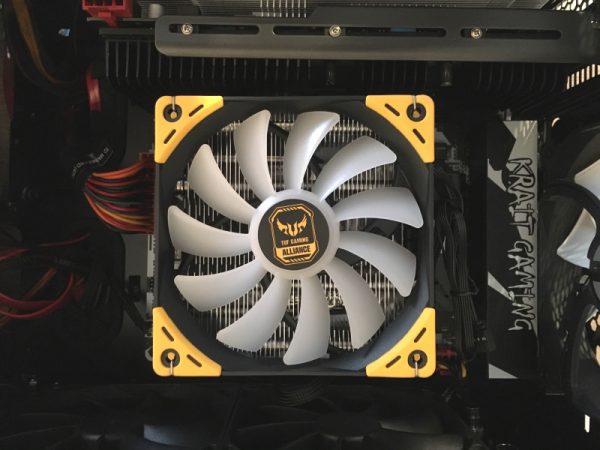
Test setup and results …
Before we get to the measurement results, we start with the components in our test system and then take a look at our measurement procedure.
The test system is constructed as follows:
| Operating system | Windows 10 (1809) |
| CPU | AMD Ryzen 5 1600X |
| RAM | 2x 8GB Samsung M378A1K43BB2-CRC DDR4-2666 @ 3464 MHz |
| Mainboard | MSI X370 Krait Gaming |
| Graphics card | Palit GeForce 1070ti 8GB PCIe 3.0 |
| SSD | Samsung M2 SSD 256GB |
| Case | Phanteks Enthoo Pro M |
| Powersupply | Sharkoon WPM700 700 Watt |
The test course is composed as follows:
The CPU is stressed by Prime95 (Version: 29.4 Build 8) and the Torture Test “Small FFTs” for 30min. The core temperature is then read out via HWInfo64 (version 5.82). Before each test we also measure the idle temperature via HWInfo64. Of course, the whole thing takes place in a closed case, and 7 12cm case fans with 500 rpm provide sufficient case ventilation.
In order to better classify the cooling performance of the two coolers, we also carried out this test with the AMD Wraith Spire and a custom water cooling system. Here’s a quick look at the water cooling and then we start with the measurements.
| CPU cooler | Aquacomputer Cuplex Kryos XT |
| Radiators | 1x 360mm (30mm thick) / 1x 240mm (30mm thick) |
| Pump | Aqua Computer aquastream Ultimate |
| Fans | 5x 12cm a 500 rpm |
In addition, we used “Keraterm KP 97” as the heat-conducting paste for all tests with the various coolers, since the heat-conducting paste supplied by Scythe would not have been sufficient for 4 coolers. The room temperature was 20°C, the CPU was not overclocked and ran 1.248V Vcore and an all-core clock of 3.7GHz. In order not to torture you any longer, here are the results of our measurements:
| Cooler | Fan speed | Idle | Load | AUX |
|---|---|---|---|---|
| Watercooling | 500 U/Min | 23.3 °C | 53.3 °C | – |
| AMD Wraith Spire | 2200 U/Min | 31.3 °C | 74.9 °C | – |
| Choten | 500 U/Min | 32.5 °C | 74.8 °C | 51 °C |
| Choten | 1000 U/Min | 31.8 °C | 65 °C | 50 °C |
| Choten | 1200 U/Min | 29.8 °C | 63.5 °C | 47 °C |
| Kotetsu Mark II | 500 U/Min | 28.5 °C | 74.8 °C | 51 °C |
| Kotetsu Mark II | 1000 U/Min | 30.3 °C | 67.5 °C | 50°C |
| Kotetsu Mark II | 1200 U/Min | 29.8 °C | 64.8 °C | 50 °C |
As you can see from the table, both the Choten and the Kotetsu Mark II are doing very well.

In comparison to AMD’s Wraith Spire, both coolers cut a very good figure. It’s also able to tame the 1600X, but only at maximum fan speed.
The Scythe Choten as well as the Kotetsu Mark II achieve the same temperature at just 500 rpm and are also inaudible at this speed. If you increase the fan speed to 1000 rpm, this barely increases the volume and you gain a bit more than 10 °C cooling performance. This allows easy overclocking without having to wear hearing protection. It looks different if you set the speed to the maximum of 1200 rpm. Here, both coolers can lower the temperature by another 2-3 °C, but are now clearly audible.
Speaking of overclocking, as already mentioned, we believe that the Scythe Choten and Kotetsu Mark II are capable of slight overclocking, but you should not expect miracles here. Since Scythe unfortunately doesn’t specify a TDP, we can only estimate that the two can handle 125W TDP depending on the fan speed.
In comparison to water cooling, of course, both are clearly lacking in cooling capacity. However, if you consider the price of the two coolers as opposed to water cooling, this is perfectly okay.
Let us now come to the AUX topic. This is a temperature sensor on our mainboard, which is located at the VRMs (Voltage Regulator Modules) of the CPU. If you take a look at the table, you can see that the Choten construction cools the voltage converters with increasing fan speed. Otherwise both coolers don’t take much as expected. This is interesting for motherboards with sparingly dimensioned VRM coolers, here the Scythe Choten can score a little better.
Scythe Choten & Kotetsu Mark II TUF conclusion and overall impression …


